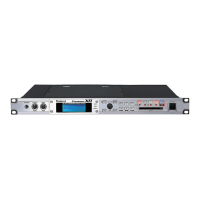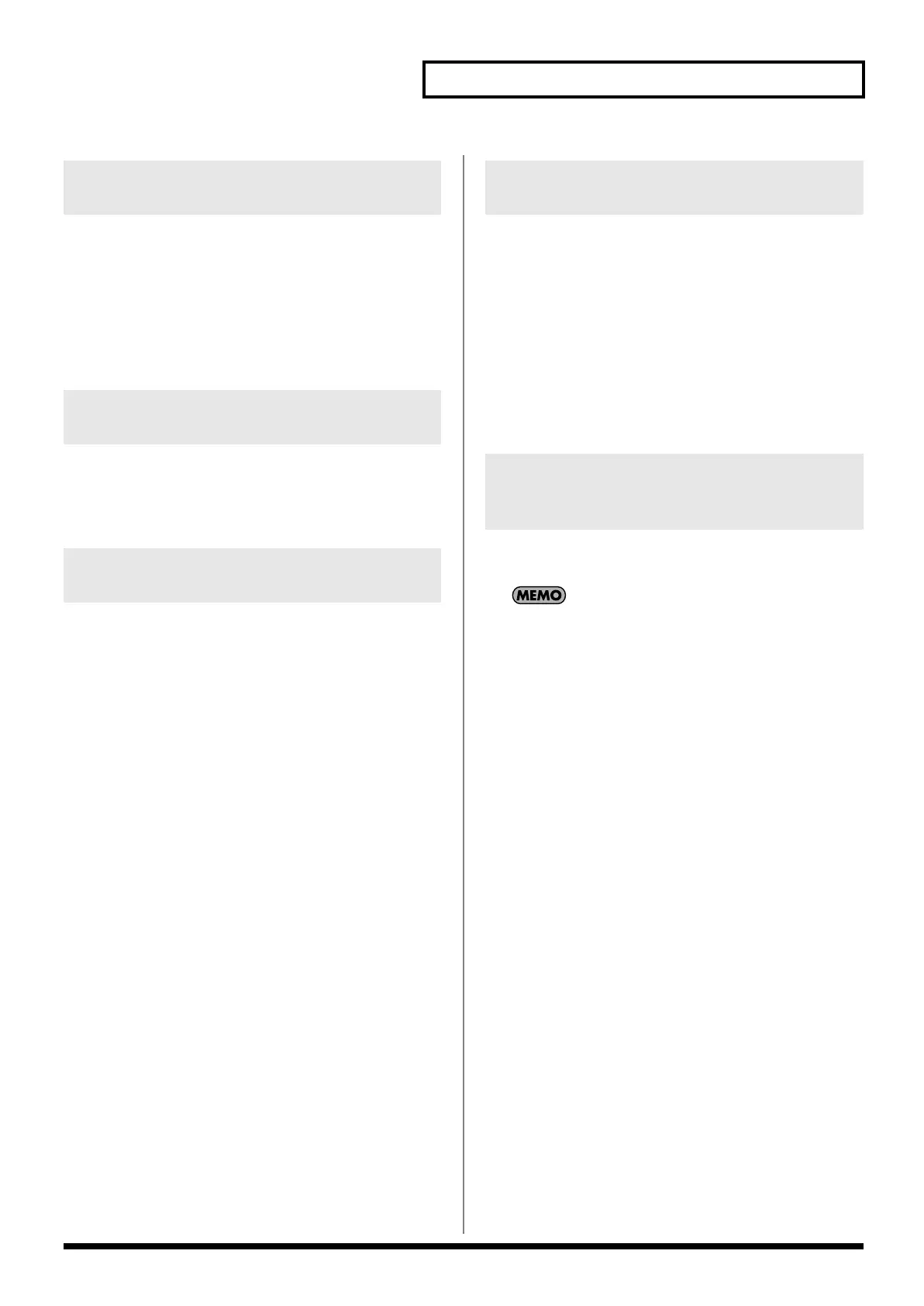99
Playing Arpeggios
When you play arpeggios, the velocity of each arpeggiated note is
determined by the velocity of the notes programmed within the
arpeggio style. You can adjust the amount (“spread”) of this
dynamic variation. With a setting of 100%, the arpeggiated notes will
have the velocities that are programmed by the arpeggio style. With
a setting of 0%, all arpeggiated notes will be sounded at a fixed
velocity.
Value:
0-100%
This adds an effect that shifts arpeggios one cycle at a time in octave
units (octave range). You can set the shift range upwards or
downwards (up to three octaves up or down).
Value:
-3–0–+3
This sets the particular note division and resolution in a “single
grid” used in creating the arpeggio in an Arpeggio Style, and how
much of a “shuffle” syncopation is to be to applied (none/weak/
strong) to it (grid type).
* Grid settings are shared with the rhythm pattern.
Value:
1/4:
Quarter note (one grid section = one beat)
1/8:
Eighth note (two grid sections = one beat)
1/8L:
Eighth note shuffle Light (two grid sections = one beat,
with a light shuffle)
1/8H:
Eighth note shuffle Heavy (two grid sections = one beat,
with a heavy shuffle)
1/12:
Eighth note triplet (three grid sections = one beat)
1/16:
Sixteenth note (four grid sections = one beat)
1/16L:
Sixteenth note shuffle Light (four grid sections = one
beat, with a light shuffle)
1/16H:
Sixteenth note shuffle Heavy (four grid sections = one
beat, with a heavy shuffle)
1/24:
Sixteenth note triplet (six grid sections = one beat)
This setting (duration) determines whether the sounds are played
staccato (short and clipped), or tenuto (fully drawn out).
* Grid settings are shared with the rhythm pattern.
Value:
30, 40, 50, 60, 70, 80, 90, 100, 120, FULL
30–120:
For example, when set to “30,” the length of the note
in a grid (or when a series of grids is connected with
ties, the final grid) is 30% of the full length of the
note set in the grid type.
FULL:
Even if the linked grid is not connected with a tie,
the same note continues to sound until the point at
which the next new sound is specified.
This selects the method used to play sounds (motif) when you have a
greater number of notes than programmed for the Arpeggio Style.
When the number of keys played is less than the number of
notes in the Style, the highest-pitched of the pressed keys is
played by default.
Value:
UP (L):
Only the lowest of the keys pressed is sounded
each time, and the notes play in order from the
lowest of the pressed keys.
UP (L&H):
Notes from both the lowest and highest pressed
keys are sounded each time, and the notes play
in order from the lowest of the pressed keys.
UP (_):
The notes play in order from the lowest of the
pressed keys. No one note is played every time.
DOWN (L):
Only the lowest of the keys pressed is sounded
each time, and the notes play in order from the
highest of the pressed keys.
DOWN (L&H):
Notes from both the lowest and highest pressed
keys are sounded each time, and the notes play
in order from the highest of the pressed keys.
DOWN (_):
The notes play in order from the highest of the
pressed keys. No note is played every time.
UP&DOWN (L):
Notes will be sounded from the lowest to the
highest key you press and then back down to the
lowest key, with only the lowest key sounded
each time.
UP&DOWN (L&H):
Notes from both the lowest and highest pressed
keys are sounded each time, and the notes play
in order from the lowest of the pressed keys and
then back again in the reverse order.
UP&DOWN (_):
The notes play in order from the lowest of the
pressed keys, and then back again in the reverse
order. No note is played every time.
Changing the Accent Strength
(Accent Rate)
Hanging the Range of the Arpeggio
(Octave Range)
Changing the Beat and Shuffle
(Grid)
Applying Staccato and Tenuto
(Duration)
Selecting Ascending/Descending
Variations (Different Ways of
Playing the Sounds) (Motif)
Fantom-XR_r_e.book 99 ページ 2006年4月4日 火曜日 午前10時14分

